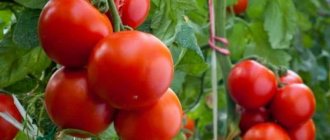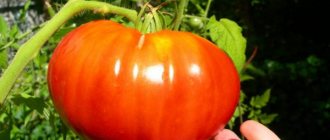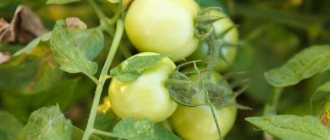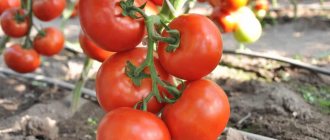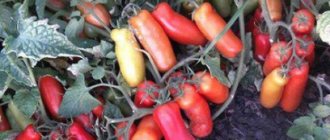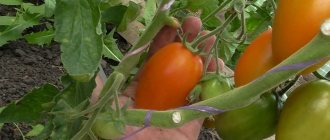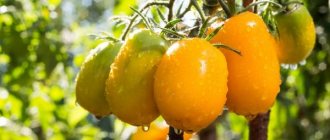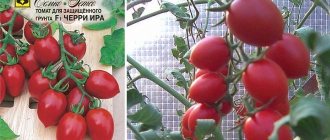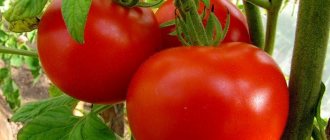History of the development of the Bella Rosa tomato variety
The Bella Rosa tomato is the result of the work of Japanese breeders who bred it at the beginning of this century. The tomato Bella Rosa f1 was included in the Russian State Register in 2010.
It is recommended for cultivation in open ground in the south of Russia - in the Astrakhan and Krasnodar regions, as well as in the Crimea. This variety is not suitable for growing in greenhouse conditions.
But Bella Rosa is popular not only in its own country and in Russia, but also in other countries of the world due to its positive characteristics.
Photo of Bella Rosa tomato
Sultan's agricultural technology
Tomato Sultan in the southern regions is grown in open ground. In cities with cold climates - in greenhouses. In the central lane, both options are possible.
In the southern regions, tomatoes are planted in a permanent place at the beginning of May, in cities with a temperate climate - at the end of May. In the northern part of Russia, seedlings are planted in protected soil at the end of May.
Before planting in a permanent place, the seedlings are fed and watered. Moist soil makes it easier to remove plants.
Planting seedlings in a permanent place
Tomatoes are light-loving plants. The sunniest area of the garden is chosen for them. Beds that did not grow nightshade crops last year are suitable.
The selected place is dug up and cleared of plants. Humus or mullein is added to the soil. If the acidity of the soil is increased, dry lime is added to it. If the soil is too dense, use river sand.
In spring, the beds are leveled with a rake. In the process, they are cleared of weeds. The holes are dug in rows in a checkerboard pattern. For 1 sq. m plant up to six Sultan tomato bushes.
Ash or long-acting fertilizers are poured into the bottom of the holes. After planting the tomatoes, the plants are watered. For each of them take 1 liter of water. The next watering will be possible only after 10 days.
Plant care
Despite their short stature, the plants need to be tied up. Otherwise they will break under the weight of the harvest. Tomatoes are attached to wooden supports or trellises. Synthetic thread is used for garter, as natural material will rot.
There is no need to prun such bushes. They form a small number of shoots, which provide the plant with high yield.
After the first flower cluster has formed, the leaves below it are removed. No more than 3 leaves are picked per week.
Tomatoes should be watered as the soil dries with warm, settled water.
It is important to ensure that the liquid does not fall on the above-ground part of the tomatoes.
After each watering and rainfall, the soil is loosened. During this process, weeds are removed.
Tomatoes are fed 3-4 times during the entire growing season. Alternate organic and mineral compositions. Before fertilizing, you need to water the plants abundantly so as not to burn their roots with fertilizers.
Twice a season, tomatoes are sprayed with foliar fertilizers. Use products containing boron.
Problems during cultivation
When growing tomatoes, gardeners sometimes face a number of problems. The list shows the reasons for some of them:
- A large amount of greenery is formed on the plants, and few ovaries. This indicates that the tomatoes are fattening. The reason is too fertile soil. Reduce the amount of fertilizing.
- Ugly fruits. The most common reasons are violation of watering conditions and temperature conditions, pests.
- Curled leaves. Sign of plant infection. Possible causes are excessive pinching and high humidity.
Diseases and pests
Tomato Sultan is resistant to most tomato diseases. However, he needs disease prevention:
Disinfection. Not only seeds, containers and soil, but also garden tools are treated with disinfectant compounds. Compliance with the rules of watering and pinching. These procedures are carried out when the sun is inactive
It is important to monitor the humidity level and prevent water from entering the above-ground part of the plants. Preventive treatments. The bushes are sprayed with a solution of potassium permanganate or copper sulfate. Protection from harmful insects
Plants are sprayed with a soap solution or wormwood decoction. Preventive examinations. Held weekly. Damaged bushes are removed.
Tomato Bella Rosa F1: variety description
This hybrid is classified as an early ripening hybrid - from the moment of germination of the seed to the harvesting of ripe Bella Rosa tomato products, about 110 days pass, and when grown by seedlings - less than two months after planting the seedlings in a permanent place.
The bushes of this tomato are of a determinate type, standard. The shoots can grow up to 0.7 m in height; they are well leafy and slightly pubescent. The foliage is medium-sized, slightly elongated, with sharp tips, slightly wrinkled, light emerald in color.
All buds are collected in inflorescences-tassels, each of which can produce up to 5 fruits.
On a note!
The shape of Bella Rosa tomatoes is round, slightly flattened at the base.
The skin is compacted, elastic, smooth, with a characteristic shine, not prone to cracking. The color of the skin and pulp is deep red. The pulp is tender, compacted, with several seed chambers (up to 7 pieces).
BEST TOMATOES!
Tomato ZHIGALO Tomato Benito F1 Tomato Spasskaya Tower F1
The number of seeds is insignificant. Since the variety is a hybrid, it is not worth collecting your own seed material - the grown plants will not have positive parental characteristics.
Photo of Bella Rosa tomato on a bush
The size of the ripe Bella Rosa fruit machine is quite large, they are even, approximately the same, weighing about 250 g
. The amount of dry matter in the fruit is up to 6%, so the fruit is unsuitable for making juice or puree.
Due to the sufficient amount of sugars, ripe tomatoes of the Bella Rosa variety have a sweetish taste, with virtually no sourness. Due to the large size of the fruit and pleasant taste, this tomato variety is classified as a salad type.
The harvested crop can be transported to different distances, while the fruits do not crack and do not lose their wonderful taste. They can be stored under appropriate conditions for quite a long time.
The best low-growing tomatoes - video
Diseases of the variety
Of course, the Bella tomato hybrid is immune to point-type tomato mosaic viruses, verticillium blight, fusarium blight, gray and white spot, and also to nematodes, it can be susceptible to fungal infections.
Tomato fungus and treatment methods
Alternaria blight
This type affects the stem, leaves and even fruits. It develops very actively in a humid environment.
Signs: spots on leaves and stem; rapid yellowing of leaves and wilting.
Fighting methods
For this type, the most effective fungicide is Ridomil Gold.
How to use Ridomila Gold:
To treat Alternaria blight, mix 60 grams of the drug in one standard bucket of water (10 liters). For four weeks, we carry out treatment once every 7 days. It is very important to carry out the procedure early in the morning in dry, windless weather.
You can use Oxychom
Application
20 grams of powder are dissolved in a 10 liter bucket of warm water. For one week, we generously spray the affected areas every day. Plants to which the disease has not spread should be sprayed a little at a time. Do not use the drug during mass flowering of the plant.
There are 2 liters of solution per 10 sq.m.
All fungicides have a strong toxic odor. It is very important to avoid contact with exposed areas of the body and the respiratory tract. Smoking, eating and drinking are strictly prohibited during treatment.
Late blight
Identified by bright brown spots on the leaves and stem. IN a humid environment they are very active and quickly spread to fruits and all nearby plants. Afterwards this plant rots.
Fungicides (Oxychom, Ridomil Gold, Fitosporin and Ordan) or biological agents (Alirin-B, Gamair) and biological agents (Alirin-B, Gamair) are used as control. ). Under no circumstances should they be mixed or alternated. Chemicals are used according to instructions. And drugs of biological origin are used in the same way. Two methods that alternate daily:
- One tablet should be dissolved in five liters of water. This solution is poured under the root of the plant. For one plant (depending on growth) there are 0.5 - 2 liters.
- Two tablets of the product must be dissolved in 1 liter. It is important that the water for the solution is at room temperature (16-18 degrees). The plant is sprayed with this solution.
Main characteristics of the Bella Rosa hybrid
The Bella Rosa hybrid is resistant to periods of drought and tolerates heat well, without reducing the rate of growth and ripening of fruits. But a decrease in temperature and cold weather negatively affect this vegetable crop. With frequent temperature changes, the bushes of this tomato may die.
Productivity of the Bella Rosa tomato variety
For a low-growing variety, Bella Rosa has excellent yield - with proper care and timely feeding, at least 4 kg of ripe produce is harvested from each bush. Fruiting is extended over time - ripe products are harvested throughout the summer season.
Area of application of fruits
Due to their pleasant taste, Bella Rosa tomatoes are used fresh, and they are also added to vegetable salads or snacks. Large fruits do not fit whole into jars, so they are usually canned only in pieces - they are made into winter salads or pickled.
Large-fruited, delicious varieties of tomatoes!
Mushroom basket Pink giant Heavyweight of Siberia
Advantages and disadvantages
Gardeners who have already grown the hybrid have noted the advantages and disadvantages of the plant. According to the manufacturer’s description, the tomato is endowed with the following positive characteristics:
- Early ripening.
- Long fruiting period.
- Good yield. With proper care, up to 7 kg of tomatoes can be harvested from 1 m² per season.
- The presented tomato is a first generation hybrid, which naturally indicates high viability.
- The fruits have a marketable appearance and tolerate transportation well.
- The plant is not susceptible to many of the diseases that affect tomatoes.
Bella Rosa is a tomato that has a number of obvious advantages:
- Early ripening appearance;
- Good yield indicators;
- Simultaneous ripening of fruits;
- Long shelf life;
- Tolerates hot weather well;
- The appearance does not change due to a lack of life-giving moisture;
- Excellent taste characteristics.
Tasty Belarusian tomatoes also have a number of shortcomings, which everyone who decides to grow them needs to know:
- They do not tolerate cold and strong temperature drops;
- Requires complex fertilization;
- Weakly tolerate transportation;
- Not suitable for making juices and purees;
- Requires mandatory tying;
- Susceptible to the appearance of parasites.
By following all the recommendations, the gardener will grow strong, healthy tomatoes, the taste of which can be enjoyed during ripening and throughout the coming winter.
Pros and cons
The main advantages of the Bella Rosa tomato include:
- high productivity;
- low maintenance and unpretentiousness;
- beautiful appearance of ripe tomatoes;
- the taste of the Bella Rosa tomato is sweetish with a slight sourness, so the fruits of this variety are classified as salad;
- fruiting is extended over time;
- the harvested crop can be stored for a long time in appropriate conditions;
- the Bella Rosa tomato grows well and bears fruit in hot weather and periods of drought;
- fruits ripen in a short time;
- high resistance to diseases;
- the collected fruits can be transported to different distances.
But these tomatoes also have their drawbacks:
- low resistance to attacks by “harmful” bugs;
- cold or sudden temperature fluctuations are harmful to this variety;
- Regular fertilizing is required;
- The fruits contain too much dry matter, so they are not suitable for making juice or paste.
Harvesting and storage
Bella Rosa tomatoes are harvested every day at a temperature of +23. For fresh use, tomatoes are harvested at the stage of consumer ripeness. Such fruits are stored for no more than one week. You should not wait until the tomatoes are overripe, as their flesh becomes loose and the vegetables themselves lose their beneficial qualities. For canning and transportation, tomatoes are harvested during the technological stage of ripening. After harvesting, the specimens ripen within ten days. Conditions for storing the harvested crop:
- Whole and healthy specimens are selected for storage;
- the tomatoes are dried and laid out in two layers in wooden boxes;
- the room temperature should not fall below 20 degrees, the humidity percentage should be at 80%;
- it is important that the room is well ventilated;
- For longer storage, tomatoes should be sprinkled with sawdust and left in a dark room at a temperature of 10 degrees.
If long-term storage is required, the fruits are harvested at the biological stage of maturity. The final harvest takes place before the first frost. It is recommended to remove diseased tomatoes along with high-quality tomatoes - this way the infection will not spread to the rest of the fruits.
Rules for growing Bella Rosa tomatoes: planting seedlings and transplanting to a permanent place
Typically, this variety is grown by seedlings - in this case, it is possible to obtain harvests several weeks earlier than the period indicated in the description.
Sowing Bella Rosa tomato seeds for seedlings is carried out in March - a couple of months before transplanting the seedlings to a permanent place. Specific planting dates are calculated depending on weather conditions in the growing regions.
It is important to know!
Since the variety does not tolerate low temperatures and is not intended for cultivation in greenhouse conditions, Bella dew is not recommended for planting in regions with harsh climates.
Seed preparation
Seeds of this variety cannot be collected from bushes in the garden - the plants grown from them will not retain positive parental characteristics. Therefore, seed material must be purchased annually from specialized stores.
How to germinate tomato seeds
Such seeds undergo pre-sowing treatment in companies that sell them. Therefore, at home, they only soak tomato seed material in damp gauze for germination. Growth stimulants can be added to the water.
Preparation of nutrient substrate
Nutrient substrate for growing tomato seedlings is usually purchased in specialized stores. But you can cook it at home. To do this, in the fall, gardeners stock up on garden soil, humus or compost, coarse river sand and peat. In the spring, all these components are mixed, wood ash and sphagnum moss are added to make the soil loose.
INTERESTING!
Iodine for tomatoes against late blight.
Home-prepared soil mixture for seedlings should be disinfected before use. To do this, it is calcined in an oven heated to 180 degrees for 30 minutes.
Sowing tomato seeds for seedlings
The prepared substrate is laid out in containers, grooves no more than 1 cm deep are made in it. The distance between the grooves is about 2.5 cm. The seed material is laid out in the grooves at a distance of a couple of centimeters from each other. Then the ground is leveled and watered with a spray bottle.
The top of the container with Bella Rosa tomato seedlings is covered with polyethylene and transferred to a dark, warm room until the sprouts appear.
Typically, seed material begins to actively germinate 5-6 days after sowing.
When to pick tomatoes?
Further care of Bella Rosa seedlings
After the shoots emerge, the polyethylene must be removed and the containers moved to a well-lit place. In the future, caring for Bella Rosa seedlings consists of regular watering and fertilizing.
Video about tomato seedlings
Tomatoes are watered as the soil dries with warm filtered water. If the water is cold, then such watering can provoke the development of blackleg or root rot in seedlings.
After the seedlings have a pair of permanent leaves, they should be picked into separate containers. 10-12 days after picking, the first fertilizing of Bella Rosa tomatoes is applied to the soil.
Usually urea or other fertilizers containing nitrogen are used for this.
. 12-14 days before transplanting plants to a permanent place, a second feeding should be done. Its composition does not differ from the first feeding.
On a note!
10-12 days before planting the seedlings in the beds, they are hardened off. To do this, the tomato plants are taken out onto the balcony or loggia for a short time at first, but gradually the time the plants stay outside increases.
Transplantation to a permanent place
The area for planting tomatoes is prepared in advance. Compost is added to the depleted soil before digging in the autumn - 7-8 kg for each square of area. In spring, 20 g of potassium salt and superphosphate are added to the planting holes.
When replanting, you need to remember that no more than 4 Bella Rosa tomato bushes should grow on each square of area.
Bella Rosa tomato seedlings are transplanted into open ground in mid-May, when it warms up well.
. The plants are transferred to the planting holes together with a lump of earth; if necessary, soil is added to the holes, compacted and watered. Then the root zone of the plants should be mulched.
How to fight diseases and insects
The Bella Rosa hybrid is protected at the genetic level from viral diseases, but is susceptible to bacterial damage, rot and insect attacks.
To combat slugs and spider mites, use a soap, garlic or mustard solution, and decoctions of thyme, sage and lavender to wipe the leaves. Ash mixed with hot pepper is scattered around the bushes.
To prevent late blight, use:
- a solution of copper sulfate before flowering begins (for 10 liters of water, 2 tablespoons of copper sulfate);
- "Fitosporin" (diluted according to instructions);
- “Trichopol” (1 tablet per 1 liter of water);
- iodine solution with milk (9 liters of water + 1 liter of milk + 15 drops of iodine);
- hay tincture (infused in 10 liters of water with 2 tablespoons of urea for 4 days).
If infection cannot be avoided, diseased leaves and fruits are removed and burned, and the instrument is disinfected.
Disease prevention measures:
- Maintain a distance between seedlings (at least 50 cm).
- Mulching the soil.
- Removing the lower leaves.
- Moderate watering.
Further care for the Bella Rosa tomato
In the future, you should carry out regular watering, fertilize, loosen the soil, and tie the Bella Rosa tomato bushes to supports.
Rules for watering tomatoes
Bella Rosa tomatoes do not tolerate excessive soil moisture, so they need to be watered once every few days. Water for irrigation must be left in the sun to keep it warm.
After each watering, the soil should be loosened to break up the dry crust that forms on the surface of the soil. At the same time, all weeds are removed.
The shoots must be tied to strong supports so that they do not break under the weight of ripening fruits.
Diseases and pests
The plant is not susceptible to most diseases. But for prevention purposes, it is recommended to treat it with special solutions against pests and fungi.
Correct agricultural technology will help you avoid many problems:
- compliance with the planting scheme - if the thickets are too dense, the risk of rotting of roots, fruits, and branches increases;
- mulching the soil is a natural barrier that protects against bacteria;
- removing the lower leaves and ventilating the greenhouse.
If aphids appear on the bush, it can be sprayed with warm soapy water. Garlic or mustard solution drives away slugs. And also a decoction of fragrant herbs - sage, thyme, lavender.
The variety is resistant to various types of ailments that are characteristic of melons and nightshades. But prevention should still be carried out. This must be done with the help of special preparations that can be purchased at any gardening store.
Bella Rosa F1 tomato Sakata Antifake
Honest Review of Tomato Hybrids from the Happy Farmer
Experience of growing Belfort F1 tomato in Astrakhan.
Insects rarely attack these tomatoes. But in order to eliminate all risks, it is better to plant plants next to the tomato that repel melon and melon pests.
The Bella Rosa variety is very resistant to diseases characteristic of most tomatoes. However, gardeners should not forget about preventive measures. In order to grow healthy bushes, it is necessary to follow the watering regime and fertilize the soil. In addition, the ground under the plants should be regularly weeded and loosened.
The Bella Rosa variety is susceptible to attack by spider mites and slugs.
The following methods are used to control pests:
- Plants damaged by spider mites should be wiped with soapy water;
- Mulching the soil with pine needles, crushed shells or sawdust will help get rid of gastropods;
- Ash and hot pepper are also used against slugs, which are scattered between the beds.
Tomato Bella Rosa F1: reviews of cultivation, those who planted the variety
Irina, 35 years old, Sochi: In our region, the weather is quite hot and dry all summer, and since my summer cottage is located quite far away, I cannot come there often and water the planted vegetables. Therefore, for a long time I could not find a variety of tomatoes that could grow and bear fruit normally in such conditions. A neighbor at my summer cottage advised me to grow a Bella Rosa tomato. I planted him and did not regret it. The fruits ripen early, there was no special hassle with seedlings and further cultivation of tomatoes on the site. I watered them twice a week and fed them once every 10 days. As a result, the fruits grew large (about 350 g), sweetish and very beautiful in appearance. I used the harvest to make salads, and also closed some salads with this tomato for the winter.
Yana, 45 years old, Ulyanovsk: Rosa read about the Bella Rosa tomato on the Internet and decided last year to plant this variety in her garden for testing. I planted 16 bushes, which I grew in seedlings. I watered and fed it as stated in the description for the variety. The fruiting of the variety was extended over time; in just one season, 4 kg of ripe fruits with good taste were collected from each bush. But there was nothing left for canning - all the collected tomatoes were eaten by my family, and they also prepared salads and other snacks. Next season I will plant more bushes of this variety.
The Bella Rosa F1 tomato variety is unpretentious, tolerates heat and periods of drought well, and at the same time has good yield.
. In order for ripening tomatoes to be large enough, it is necessary to regularly feed adult plants and follow the watering regime.
Characteristics of Bella Rosa tomato fruits
The Bella Rosa F1 tomato hybrid is distinguished by small fruits. One ripe tomato weighs up to 120 grams on average. Maximum weight – 250 g. Tomatoes are oval-flat in shape. There is a slight ribbing near the stalk. There are a large number of seed chambers inside the tomato. The skin is smooth and thin. The tomatoes themselves are a rich scarlet hue.
High yield, from one bush you can harvest from 8 kg of vegetables. From 1 sq. m. – from 15 kg of ripe fruits. From 7 to 9 tomatoes are formed in the brush.
The main advantage of this variety is the shelf life of vegetables. Red tomatoes can be stored for more than 2 weeks. Green fruits collected in late August or early September can last until October.
See also
Characteristics and description of the tomato variety King of Kings, its yieldRead
The tomatoes themselves are sweet and juicy. Well suited for preparing fresh salads and eating whole. They can also be used for canning as a whole. During the salting process, they fit well into jars and do not crack.
Soil and watering
Dutch tomato hybrids love light, loose soil with a large proportion of organic components. Garden soil is supplemented with compost, humus, sawdust and peat. Before planting seedlings, water the soil generously with boiling water.
The bush is buried a little so that the plant produces additional lateral roots. Water Belle f1 tomatoes moderately, allowing the soil to dry out a little, but not allowing the green mass to wilt. To save yourself from the need for frequent loosening, the soil is mulched with a thick layer of sawdust or peat. Every 2-3 weeks, tomatoes are fed with complex mineral fertilizers.
